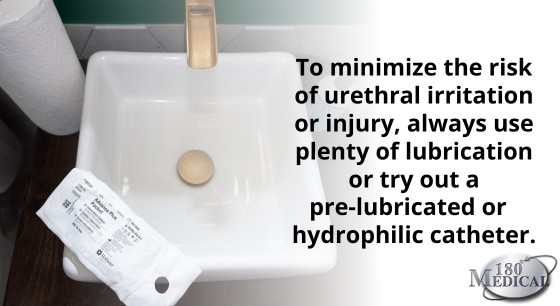
Are you seeing blood in your urine or inside your intermittent catheter after using it? Blood in urine, also known as hematuria, can definitely be a scary sight for anyone. However, don’t panic right away. Hematuria has a lot of potential causes, including catheter-associated UTIs.
Get more details with our helpful guide, such as what hematuria is, potential causes, and tips for what to do next.
What Is Hematuria (Blood in Urine)?
According to the Urology Care Foundation, hematuria is a medical term referring to the presence of blood in urine. While it may be alarming, it may be manageable and even preventable in some cases.
Hematuria typically falls into two categories:
- gross hematuria, which is visually evident as pink, red, or dark urine or regular urine with clots or fragments of blood
- microscopic hematuria, which is detectable only under microscopic examination
Why Is There Blood in My Urine?
So what causes hematuria? Why are you seeing blood inside your catheter during or after use? There are several causes for seeing blood in urine, some of which may be preventable or manageable. Other causes may require immediate medical treatment.
A few potential causes of hematuria in catheter users may include:
- UTIs (urinary tract infections)
- Kidney infections
- Interstitial Cystitis (IC), also known as Bladder Pain Syndrome
- Urethral trauma (due to improper catheterization techniques such as forcing a catheter in or not using enough lubrication)
- Bladder or kidney stones
- Bladder cancer
- Kidney disease
Sometimes, medical conditions such as an enlarged prostate or endometriosis may also cause blood to appear in the urine.

What Do I Do If There’s Blood in My Urine?
Hematuria is a symptom, not a disease. If you notice blood in your urine, it’s a sign that something is not right inside your body.
While it’s crucial to address this issue as soon as possible, remember that hematuria can be caused by many things. The cause of hematuria could be as simple as a UTI, which is typically one of the most common and easily treatable types of infections.
However, don’t put off talking to your doctor, especially if you’re experiencing other symptoms like pain, difficulty urinating, difficulty inserting your catheter, or severe bleeding. These are serious symptoms, and you need to seek immediate medical attention.
Either way, when you see any amount of blood in your catheter or your urine, let your prescribing healthcare provider know what’s going on.
Diagnosis may require a physical exam, a urine sample for analysis, or even a scan such as an ultrasound or MRI.
Can Using a Catheter Cause Hematuria (Bloody Urine)?
It’s possible, especially if the urinary catheter you’re using isn’t well-lubricated, which can cause urethral friction. The inside of the urethra (the tube leading from the bladder to the outside of your body) is very delicate. Friction from a catheter that is too large, not lubricated or not well-lubricated, or simply not the right one for your unique anatomy can cause micro-tears, which can lead to small amounts of blood in urine.
The first step is to talk to your prescribing healthcare provider about what’s going on to see if there’s another underlying cause or another size of catheter that may work better.
180 Medical has over 20 years of experience specializing in intermittent catheters. We pride ourselves on helping our customers overcome issues by finding just the right catheter for their unique anatomy, lifestyle, and needs.
If you’re not sure if you’re practicing proper catheterization technique or if you’d like to explore your other catheter options to see if there’s a more comfortable option for you, our friendly specialists are ready to help you! Reach out to us to discuss your options or request free catheter samples.
How to Prevent Hematuria in Catheter Users
Those who are new to using catheters may be more likely to see blood in urine due to new urethral irritation. This may occur while you’re still trying to master your catheterization technique, or it might occur because you’re not using the most suitable catheter for your anatomy.
While not all instances of hematuria can be prevented, catheter users may want to consider a few things.
- Are you using practicing a safe, hygienic catheterization technique?
- Are you drinking enough water and staying hydrated?
- Are you following your doctor’s prescribed catheterization schedule?
- Are you using a catheter that is the right size and type for your anatomy?
- Are you making sure your catheter is fully lubricated?
Here are a few tips that may help.
1. Avoid reusing catheters.
You may want to avoid reusing your catheter, as studies show this practice may raise the risk of infection. After using a catheter once, it’s next to impossible to get it sterilized again at home. This can leave behind potential pathogens and bacteria, which may cause pesky but common UTIs.
2. Stay optimally hydrated.
Drinking water isn’t just great for your overall physical health. It may also help reduce stress on your kidneys and urinary system. Plus, it can keep your system flushed. Talk to your doctor about how much water is right for you and if there are any fluids you may want to avoid, such as caffeine or alcohol, due to bladder irritation.
3. Never force your catheter in.
If you’re experiencing some resistance when you try to insert your catheter, don’t force it in. This could cause damage to the urethra or excess friction. Resistance may be due to a false passage or a urethral obstruction. Other times, it may be due to using an improperly sized catheter, such as a catheter with a French size (diameter) that is too large for your anatomy’s urethra.
Either way, if you’re encountering some resistance that’s making it very difficult to insert your urinary catheter, it’s time to call your prescribing healthcare provider. If you depend on catheters to fully drain your bladder, it’s crucial that you use them on schedule so your bladder doesn’t overfill.
4. Practice proper hygiene when cathing.
Catheter-associated UTIs can be common, but practicing optimal hygiene and keeping your hands off the catheter tube may help.
180 Medical offers step-by-step instructions for how to hygienically self-catheterize, including catheterization videos for specific catheter types (straight, hydrophilic, and closed systems).
But here are a few quick tips for starters. Always be sure to wash or sanitize your hands before and after use. Using disinfecting wipes such as BZK or povidone-iodine around the urethral opening may also be helpful, especially if you find yourself experiencing recurrent UTIs.

5. Make sure your catheter is always well-lubricated.
The urethra is actually pretty delicate. Using an uncoated catheter that isn’t well-lubricated may cause friction and even micro-tears inside your urethra. If you’re using an uncoated straight catheter, 180 Medical offers plenty of sterile, water-soluble catheter lubricant options, including ideally dosed individual packets.
If you’re using a hydrophilic catheter, make sure the hydrophilic coating or properties have been fully activated by water so it’s super slippery and ready to use before inserting it.
6. Get the right catheter for your needs.
At 180 Medical, we know one thing for sure: there is no single catheter that works for everyone. Catheters aren’t a one-size-fits-all medical supply. That’s why intermittent urinary catheters come in different sizes, types, and features to suit different users’ needs and bodies.
Depending on your health insurance plan’s coverage for catheter supplies, you may want to try a catheter designed to protect the delicate urethra, such as the GentleCath™ Glide Catheter. It’s the next generation in catheter technology, featuring unique FeelClean Technology™, which becomes slippery when wet to make insertion easier and more comfortable.
180 Medical carries one of the widest selections of catheter options from all major manufacturers and brands. When you choose 180 Medical, you’re not limited to just one brand or option.

Contact 180 Medical today to request catheter samples, verify your insurance plan’s catheter coverage, and get started. We’re here for you every step of the way.
Disclaimer: This content is not intended to substitute for professional medical advice, diagnosis, or treatment. Please do not use it in place of a visit or consultation with a qualified healthcare provider.